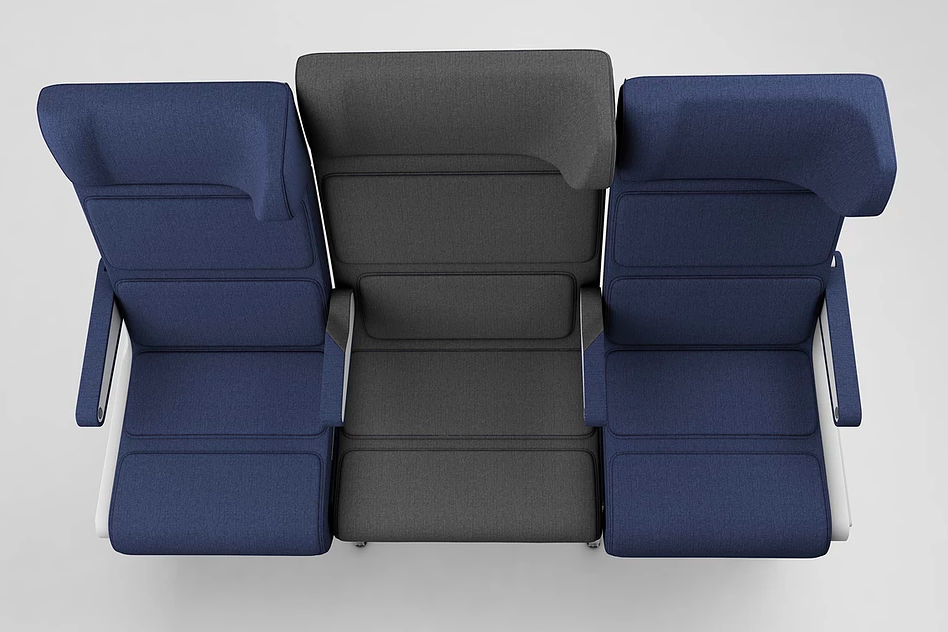
With summer travel in full swing, many are reminded of the uncomfortable conditions most airlines provide on their planes. Leg room, seat width and recline have decreased to pack more people into less space.
In the last 30 years, seat widths on major airlines have shrunk around two inches. New seat patents circulating the internet don’t give much hope. One example turns the middle seat backwards — ideally bringing more shoulder room for all passengers, but also creating uncomfortable eye-contact with strangers.
Refreshingly, a new invention by the Denver startup Molon Labe Seating provides a realistic solution for the middle seat. It is newly approved by the Federal Aviation Administration (FAA) and is ready to be installed in at least one airline.
The design alters seat layout slightly to give every passenger the illusion of more room. There are three elements that customers and airlines alike will find enticing about this invention: staggered and wider middle seats, wider aisles during takeoff and landing and for an airline's bottom line, overall lighter seats.
Staggered seats add comfort
Molon Labe’s seats look familiar, expect that the middle seat is slightly lower and behind the window and aisle seats. The armrests also have two levels — leaving the back for the middle seat and the higher front for the aisle and window.
But the biggest selling point for customers might be the seat width — the middle seat is 21 inches, while the others are a standard 18 inches. For comparison, some airlines have decreased seat widths to 16 inches.
While the staggered design adds comfort for passengers, it will not decrease seating capacity. Flying the same number of people means this improvement won’t increase an airline’s carbon footprint.
Wider aisles decrease takeoff and landing time
The design also widens the aisle during takeoff and landing — the aisle seat can shift over the middle seat to make the aisle over twice as roomy. The amount of space shifts from 19 inches to 41 inches with only the push of a button, thus accommodating two people side-by-side or even a wheelchair.
“When you stop in the aisle to take off your jacket and pull your iPad out, everyone else stops,” Hank Scott, the founder and CEO of Molon Labe told The Denver Post in 2015. “Now the line won’t stop. Just get out of the way and let people walk around you.”
It’s not only passengers who will be happy with quicker boarding and deplaning times. Shorter turnarounds, especially for short-haul flights, save airlines money. Simply slipping the seats aside could save airlines 6.7 minutes per trip. This translates to $670,000 a day or $245 million a year, according to calculations courtesy of the Denver Post.
Lighter seats decrease carbon emissions
Another positive for atmospheric CO2 is that these seats are on the lighter side — being mostly aluminum, they weigh under 20 pounds each. The average weight for an airplane seat is 22 pounds.
In an industry that defies gravity, weight is a major consideration. Some airlines, such as this Japanese carrier, have gone to extremes to decrease the weight of their aircraft.
Other benefits to airlines
This invention is the first major seat redesign that benefits economy passengers. Any airline that buys into this staggered seat will give the impression to its customers that it cares. Doing so speaks loudly in an industry where airlines often put profit over person with practices like overbooking flights.
While airlines have generally done well with customer satisfaction in recent years, the in-flight experience leaves much to be desired. Of course, food and entertainment could be better, but seat comfort beats them both out. With a score of 69 out of 100, seat comfort was the lowest scoring category in this past spring’s American Customer Satisfaction Index report.
Middle seats are an untapped opportunity for airlines. Only three percent of airplane passengers claim to prefer the middle seat — mostly after a travel companion has already selected their seat. Disdain for middle seats translates into lost revenue.
Molon Labe’s design gives the middle seat its own advantage — size — thus increasing the chances airplanes will fly full.
And of course, some airlines may capitalize on the improved design by adding a surcharge for middle seats. Although, that may not be the best way to keep customers satisfied.
What’s in store for the staggered seat?
The design has been finished for a few years, but it only got FAA approval last month. An undisclosed airline already has plans to install the seats on 50 of its planes by 2020.
These first seats won’t include the slide-slip technology.
Scott explains to Fast Company, “We decided two years ago to focus on getting the S1 flying as it is . . . then once an airline is flying and happy with our seats and support, we will offer to upsell some Side-Slip Seats. It’s such a risk-averse industry that it made more sense to offer a nonmoving seat to start with.”
The company has focused on getting its short-haul design into planes — after all, that’s where seating is the tightest — but it also has a design for longer flights with added comfort features including privacy barriers.
While Molon Labe’s seats don’t solve all the horrors passengers associate with flying, they are a good start for returning to a place of comfort. While the seats won’t be available for this year’s summer travel, it’s nice to finally have hope for the near future. And for airlines, these staggered seats offer an opportunity to revive their industry’s reputation - one that currently comes across as putting customers' comfort as lower than low priority.
Image credit: Molon Labe Seating

Roya Sabri is a writer and graphic designer based in Illinois. She writes about the circular economy, advancements in CSR, the environment and equity. As a freelancer, she has worked on communications for nonprofits and multinational organizations. Find her on LinkedIn.














